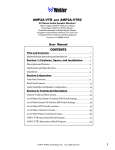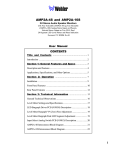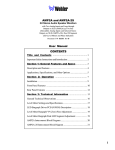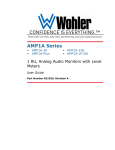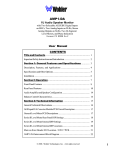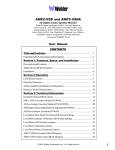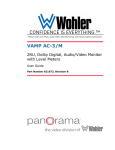Download Wohler AMP2A-10S User guide
Transcript
CONFIDENCE IS EVERYTHING.™ World Leader of In-Rack, Audio, Video, Data Monitoring, and Closed Captioning Solutions AMP2A-10S 2RU Stereo Audio Speaker Monitors User Guide Part Number 821040, Revision A © 2010 Wohler Technologies, Inc. and PANORAMA. All rights reserved. This publication is protected by federal copyright law. No part of this publication may be copied or distributed, stored in a retrieval system, or translated into any human or computer language in any form or by any means electronic, mechanical, manual, magnetic, or otherwise, or disclosed to third parties without the express written permission of Wohler Technologies. Reproduction Licensed users and authorized distributors of Wohler Technologies, Inc. products may copy this document for use with Wohler Technologies., Inc. products provided that the copyright notice above is included in all reproductions. Customer Support Wohler Technologies, Inc. 31055 Huntwood Avenue Hayward, CA 94544 www.wohler.com Phone: 510-870-0810 FAX: 510-870-0811 US Toll Free: 1-888-596-4537 (1-888-5-WOHLER) Web: www.wohler.com Sales: [email protected] Support: [email protected] Disclaimers Even though Wohler Technologies, Inc. has tested its equipment and software, and reviewed the documentation, Wohler Technologies, Inc. makes no warranty or representation, either express or implied, with respect to software, documentation, their quality, performance, merchantability, or fitness for a particular purpose. Wohler Technologies, Inc. reserves the right to change or improve our products at any time and without notice. In no event will Wohler Technologies, Inc. be liable for direct, indirect, special, incidental, or consequential damages resulting from any defect in the hardware, software, or its documentation, even if advised of the possibility of such damages. Some states do not allow the exclusion or limitation for incidental or consequential damages, so the above exclusion or limitation may not apply to you. Printing This document is intended to be printed on a duplex printer, such that the copy appears on both sides of each page. This ensures that all new chapters start on a right-facing page. This document looks best when printed on a color printer since some images may be indistinct when printed on a black and white printer. Other Technologies and Products Dolby, Dolby Digital, Dolby D, and Dolby E are registered trademark of Dolby Laboratories, Inc. Microsoft Windows, and Internet Explorer are registered trademarks of Microsoft Corporation. Last Update May 18, 2010 AMP2A-10S User Guide Introduction Overview The AMP2A series units are complete, exceptionally high-quality stereo audio monitoring systems in a compact, 2RU. These models contain three audiophile-quality drivers and three power amplifiers; two amplifiers (and two speakers) that reproduce midrange and high frequency information in stereo, and a third amp/driver combination (and speaker) that handles summed low frequency (LF) information below the 500 Hz crossover point. Topics Topics Introduction Page 1 Safety Instructions 2 Installation Recommendations 3 Description 4 Features 5 Applications 6 Specifications 6 Available Options 7 Front Panel Features 7 Rear Panel Connectors 9 Level Meter Settings and Specifications 10 Level Meter Bar Graph Fine Adjustment 12 Level Meter Bar Graph Peak LED Segment Adjustment 12 Technical Functional Diagram 13 © 2 01 0 Wo h le r Te ch n o l og ie s, I n c . A l l r i g h t s r e s e r v e d . 1 A M P 2 A - 1 0 S Us e r G u i d e S a f e t y I n s tr u c ti o n s Safety Instructions IMPORTANT: 1. Read, keep, and follow all of these instructions; heed all warnings. 2. Do not use this equipment near water or moisture. 3. Use only a dry cloth to clean the equipment. 4. Do not block any ventilation openings. Install only in accordance with the instructions in the section entitled, “Installation Recommendations” on page 3. 5. Do not install near any heat source such as a radiator, heat register, amplifier, or stove. 6. Do not attempt to plug the unit into a two-blade outlet (with only two prongs of equal width). By design, these monitors will only plug into a three-prong outlet for your safety. If the plug does not fit into your outlet, contact an electrician to replace the obsolete outlet. 7. Protect the power cord from being walked on or pinched, particularly at plug’s source on the equipment and at the socket. 8. Use only the attachments/accessories specified by the manufacturer. 9. Unplug the equipment during lightning storms or when unused for long periods of time. 10. Refer all servicing to qualified service personnel. Servicing will be required under all of the following conditions: 2 • The equipment has been damaged in any way, such as when the power-supply cord or plug is damaged. • Liquid had been spilled or objects have fallen onto the equipment. • The equipment has been exposed to rain or moisture. • The equipment does not operate normally. • The equipment has been dropped. © 2 01 0 Wo h le r Te ch n ol og ie s , I n c . A l l r i g h t s r e s e rve d . AMP2A-10S User Guide I n s ta l la t i o n R e c o m me n d a t io n s Installation Recommendations Mounting The unit is designed to install into a standard 19" rack mounted at eye level for best visual observation of the monitor screens. Note: Be sure to set the level meter input level gain calibration and VU/PPM display mode DIP switch (accessed through the top cover) before installing the unit into an enclosed rack or console. Please refer to the system interconnect block diagram Figure 1–5 on page 14 for clarification of the general signal paths into and out of the AMP2A-10S unit. Heat Dissipation The ambient temperature inside the mounting enclosure should not exceed 40° Celsius (104° Fahrenheit). Adjacent devices can be rack mounted (or stacked) in proximity to the unit if the above temperature is not exceeded. Allow a 1RU (1.75”/44.45mm) space above and below the unit for air circulation. Important: To reduce noise, the monitor does not have any fans. As a result, the heat generated by the power amplifiers, power supplies, and other components is vented by slots in the side of the unit. Therefore, as a safety precaution, we advise you to be sure to allow proper ventilation on both sides of the unit. Mechanical Bracing Even though the unit is fairly heavy, the chassis is securely attached to the front panel at eight points along its surface, not just at the four corners of the chassis ears. This feature will reduce or eliminate rear bracing requirements in many mobile/portable applications. The weight of internal components is distributed fairly evenly around the unit. © 2 01 0 Wo h le r Te ch n o l og ie s, I n c . A l l r i g h t s r e s e r v e d . 3 A M P 2 A - 1 0 S Us e r G u i d e D e s c r ip t i o n Audio Connections Connection of the audio feeds is straightforward. Please refer to the system interconnect block diagrams in Figure 1–5 on page 14 for clarification of the general signal paths into and out of the AMP2A-10S unit. Analog inputs via the 3-pin male Phoenix connectors are configured for 40K balanced connections. Electrical Interference Care should be exercised to avoid mismatched cable types and other similar causes of undesired reflections in RF signal systems. If severe enough, such reflections can result in undesirable electrical interference in the audio signals. As with any audio equipment, maximum immunity from electrical interference requires the use of shielded cable; however, satisfactory results can sometimes be obtained without it. The internal circuitry common is connected to the chassis. Power The unit comes with a standard 24VDC/3.0A internal power supply and connects an A/C mains power source (65W, 100 to 240 VAC, 50/ 60Hz) to the IEC connector provided on the rear panel of the unit. Description The unique audio design of the AMP2A-10S has two important advantages. First, it provides optimally focused sound in an ultra near field (1 to 3 feet) environment. This allows higher SPL for the operator while reducing overall ambient sound and adjacent bay crosstalk. Second, electronic rather than acoustic cancellation of bass frequencies provides positive audible detection of reversed polarity (“out of phase”) audio feeds. A unique LED display also visually shows “phase” (polarity) relationships of the signals selected for monitoring. 4 © 2 01 0 Wo h le r Te ch n ol og ie s , I n c . A l l r i g h t s r e s e rve d . AMP2A-10S User Guide Features The rear panel features ten selectable stereo pairs of analog inputs on balanced Phoenix connectors. It offers an analog output of the selected stereo source on two XLR connectors on the rear panel. Features • AMP2A-10S model features ten selectable stereo pairs of analog inputs on balanced Phoenix connectors • Both models offer front panel selection of the stereo pair input source to be monitored • Two 20-segment LED bar graph display level meters • Volume and balance controls • Stereo phase indication LEDs • Headphone output • Power indication LED • 98 dB SPL at two feet • Only two rack spaces high • Excellent high frequency response for positive detection of background whine and noise • Audible indication of phase/polarity problems • Thorough magnetic shielding for placement next to video monitors • Numerous alternate control and input options • Quick and easy installation: simply slide in the rack and connect audio and AC power © 2 01 0 Wo h le r Te ch n o l og ie s, I n c . A l l r i g h t s r e s e r v e d . 5 A M P 2 A - 1 0 S Us e r G u i d e Applications Applications The AMP2A-10S are ideally suited for use in VTR bays, mobile production vehicles, teleconferencing installations, multimedia systems, satellite links and cable TV facilities, and on-air radio studios. Specifications Table 1–1 Audio and Power Specifications for the AMP2A-10S Specification Analog Input Connectors Analog Input Impedance Peak Acoustic Out (@ 2’) Power Output RMS Each Side (4): RMS Bass (4): Frequency Response, Sixth Octave Values 20 Phoenix Terminal Block (3-pin, male) 40K balanced 104 dB SPL 14 W transient / 10 W continuous 35 W transient / 25 W continuous 80 Hz - 16 kHz ± 5 dB) (-10 dB @ 40 Hz, 20 kHZ) Input Level for Maximum 0 dBv balanced Output (Volume Full On) Hum and Noise (analog) Better than -68 dB below full output < 0.15% at any level below Distortion, Electrical input threshold 6% or less at worst case frequencies Distortion, Acoustic Input Overload Analog Out S/N Analog Out THD Magnetic Shielding Power Consumption (Average Maximum) AC Mains Input 6 above 120 Hz, including cabinet resonance; typically less than 1.5% +26 dBv balanced >90 dB <0.008% <0.8 Gauss any adjacent surface 45 W 100-240VAC, 50-60 Hz Universal © 2 01 0 Wo h le r Te ch n ol og ie s , I n c . A l l r i g h t s r e s e rve d . AMP2A-10S User Guide A v a il a b l e O p t io n s Table 1–2 Level Meter Specifications for the AMP2A-10S Specification Level Meter Type Segment Quantity LED Segment Pitch Bar Graph Length Meter Dynamics Level Gain Dynamic Range Midscale Resolution Segment Colors Scale Table 1–3 Values 20-Segment LED bar graph 20 .01” (2.54 mm) 2” (50.8 mm) VU or PPM, selectable -6, 0, +4,+8 dBu, selectable 44 dB 1 dB Tricolor (green, amber, red) +4 (peak) to -40 dB Physical Specifications for the AMP2A-10S Specification Weight Dimensions (H x W x D) Values 18 lbs. (8.2 kg) 3.5 x 19 x 12 inches (89 x 483 x 305 mm) Available Options SVC Option: Separate channel volume controls. Contact your Wohler sales representative for details. Front Panel Features Figure 1–1 AMP2A-10S Front Panel © 2 01 0 Wo h le r Te ch n o l og ie s, I n c . A l l r i g h t s r e s e r v e d . 7 A M P 2 A - 1 0 S Us e r G u i d e Front Panel Features • Speakers: The AMP2A series internal speaker system is comprised of two mid-range tweeter speakers (left and right) and one woofer speaker (center). The two side channel speakers reproduce, in stereo, only the mid and high frequencies. • Power Indication LED: This LED glows green to indicate the AMP2A-10S unit is connected to mains power and an operation voltage is present. • Audio Level Meter LED Bar Graph Displays (1 and 2): Audio levels for the selected 2-channel source are visually displayed via these two 20-segment, tri-color LED bar graph meters. Dynamic range for these meters is 44 dB and they are able to display signal levels using either PPM or VU standards. Both the input level gain calibration and VU/PPM display mode for each of the two meter bar graphs is user selectable via two DIP switch modules accessible through the top cover of the unit (see page*** for DIP switch settings). Contact the factory for additional information concerning meter scales and ballistics. • Volume Control Pot: This controls the loudness of the audio reproduced by the internal speakers or connected headphone. Clock-wise rotation of this control increases the loudness of the monitored audio. • Headphone Jack: Select the headphone audio sources as you would for the internal speakers. When you plug in headphones, the speakers will mute. This jack accepts a standard 1/4” phone type stereo plug. • Phase Indication LEDs: These three LEDs offer instant verification of phase (polarity) conditions in the pair of channels selected for monitoring in the left/right channel speakers. There are three LEDs; the two smaller LEDs labeled FAST-IN and FAST-OUT show instantaneous phase relationships in the signal, while the larger LED, labeled AVG, will indicate the average phase condition. The small FAST-IN LED glows (or blinks) GREEN when signals are in-phase. The small FAST-OUT LED glows (or blinks) amber for out-of-phase signals. The larger AVG LED indicates the average phase condition by glowing green for in-phase conditions, or red for out-of-phase conditions. In general, it is sufficient to regard the AVG LED (average phase condition) as adequate for proper phase monitoring. While it is normal for stereo signals to contain some 8 © 2 01 0 Wo h le r Te ch n ol og ie s , I n c . A l l r i g h t s r e s e rve d . AMP2A-10S User Guide Rear Panel Connectors intermittent instantaneous out-of-phase and in-phase conditions (small LEDs), a steady red glow of the larger LED almost always indicates an out-of-phase alarm condition. • Balance Control Pot: This control pans the volume balance between the left and right speakers. • Source Select Switch: This 10-position rotary switch selects one of ten stereo pair inputs for monitoring through the speakers (or headphones) and level meters. The numbers on this switch correspond to the numbers silk-screened above the Analog Input connectors on the rear panel (See Figure 1–2 below). Rear Panel Connectors Figure 1–2 SERIAL NO. AMP2A-10S Rear Panel Power Connector Wohler MONTH YEAR Technologies Tel +1-510-870-0810 Fax +1-510-870-0811 www.Wohler.com 100-240 VAC 50/60 Hz 1.0 A INPUTS 6 1 2 3 4 5 + - + - + - + - + - AMP2A-10S 253862-01 7 8 9 10 + - + - + - + - CHANNEL A (LEFT) + - 1 2 3 CH. B (R) 1 2 3 CHANNEL B (RIGHT) SELECTED OUTPUT MADE IN U.S.A. Power CH. A (L) Analog Inputs (Left and Right) Analog Outputs (Left and Right) • Power (IEC-320): Attach a standard IEC power cord between this connector and mains power (100 to 250VAC, 50/60 Hz). The front panel Power Indication LED will glow green to indicate operating voltages are present. • Analog Input Connectors - Balanced Phoenix: These 3-pin male Phoenix connectors inputs, CHANNEL A (LEFT) and CHANNEL B (RIGHT) accept standard analog audio signals and are configured for balanced 40K connections. The two banks of inputs are comprised of ten connectors each for a total of twenty inputs (ten stereo pairs). Stereo pair numbers silk-screened above the connectors correspond to the numbers available for selection by the Source Select Switch on the front panel. © 2 01 0 Wo h le r Te ch n o l og ie s, I n c . A l l r i g h t s r e s e r v e d . 9 A M P 2 A - 1 0 S Us e r G u i d e L e v e l M e t e r S e t t in g s a n d S p e c if i c at i o n s Connector pinout information is silk-screened between the two banks of input connectors. • Selected Output Connectors (3-pin male XLR): These connectors are analog outputs of the Analog Input Connectors (Item B or C) as selected by the Source Select Switch on the front panel. The left connector outputs the left channel (Channel A) and the right outputs the right channel (Channel B). Both connectors are configured for low impedance connections and the output signals are not affected by the volume/balance controls or headphone mute. For XLR connector pinout information see the diagram in Figure 1–3 on page 10. Figure 1–3 Male XLR Pin-Out Level Meter Settings and Specifications Level Meter DIP Switch Settings Two DIP switch modules, accessed through holes in the top cover, allow the user to set the VU/PPM display mode and input level gain calibration. There are two DIP switch modules; one for each of the two meter bar graphs. There are four sections (1, 2, 3, 4) on each DIP switch module. The first two sections (1 and 2) are for setting the level meter input level gain calibration and the second two sections (3 and 4) are for setting the VU/PPM display mode. 10 © 2 01 0 Wo h le r Te ch n ol og ie s , I n c . A l l r i g h t s r e s e rve d . AMP2A-10S User Guide L e v e l M e t e r S e t ti n g s a n d S p e ci f i c a t i o n s Input Level Gain Calibration Settings DIP switch sections 1 and 2 set the level meter Input Level Gain Calibration, which determines the level of the input signal that will result in a 0 reading on the meter bar graph. The factory setting is +4 dBu, but can be set for -6 dBu, 0 dBu, or +8 dBu by the user. See the diagram below for settings. Note: Example: Each bar graph segment will turn on at 0.5 dB before that segment’s silk-screened scale indication. When the gain calibration is set for +4 dBu, the zero indication on the level meter will light up at 3.5 dBu. Calibration is implemented in this way to effect a rounding function for more accurate indication of signal levels which occur between the thresholds of any two bar graph segments. Bar Graph Display Modes DIP switch sections 3 and 4 determine how levels are displayed (PPM or VU mode characteristics). The factory setting is VU. See the diagram in Figure 1–4 below for settings. Figure 1–4 DIP Switch Settings © 2 01 0 Wo h le r Te ch n o l og ie s, I n c . A l l r i g h t s r e s e r v e d . 11 A M P 2 A - 1 0 S Us e r G u i d e Level Meter Bar Graph Fine Adjustment Level Meter Bar Graph Fine Adjustment 1. To remove the top cover, remove the top cover screws (2 along upper front panel, 2 per each side, 3 along upper rear panel, and 1 center top). The 919030 PCBs (2 each) are vertically mounted to the chassis bottom just behind the front panel-mounted LED bar graph displays, one for each bar graph. 2. To adjust the pot locations and functions, locate P1 on the 919030 bar graph driver PCB(s) you wish to adjust. The P1 trim pot faces upward from the PCB edge. Of the two trim pots visible (P1 and P2) it is the closest to the front panel as mounted to the chassis. 3. Connect an analog audio signal of an amplitude of approximately 1 kHz of the amplitude desired to give a “0” indication on the bar graph to the input of the bar graph you wish to adjust. 4. Turning the P1 pot clockwise increases the displayed level (sensitivity) of the associated bar graph meter. For example, to set the zero level at +7 dBu (rather than the factory default setting of +4 dBu), adjust the level input gain calibration DIP switches for gain closest to that desired. Feed an analog audio signal of +7 dBu amplitude (as in Step 3) into the input on the rear panel, then turn the pots counter-clockwise as you visually monitor the associated bar graph meter on the front panel until the desired display setting (“0”) is achieved for the increased input level. To zero the meters for a lower input level, you would turn the pots clockwise to increase the displayed level for any decreased input level. Level Meter Bar Graph Peak LED Segment Adjustment 1. 12 Remove the top cover screws (2 along upper front panel, 2 per each side, 3 along upper rear panel, and 1 center top). The 919030 PCBs (2 each) are vertically mounted to chassis bottom just behind the front panel mounted LED bar graph displays; one for each bar graph. © 2 01 0 Wo h le r Te ch n ol og ie s , I n c . A l l r i g h t s r e s e rve d . AMP2A-10S User Guide T e ch n ic a l F u n ct i o n a l D i a g ra m 2. Locate P2 on the 919030 bar graph driver PCB(s) you wish to adjust. The P2 trim pot faces upward from the PCB edge. Of the two trim pots visible (P1 and P2) it is the farthest from the front panel as mounted to the chassis. 3. Connect an analog audio signal of an amplitude of approximately 1 kHz of the amplitude desired to give a “Peak” indication on the bar graph (top segment) to the input of the bar graph you wish to adjust. 4. Turning the P2 pot clockwise increases the displayed level (sensitivity) of the associated bar graph meter. For example, to set the Peak LED Segment level at +10.5 dBu (rather than the factory default setting of +9.5 dBu), feed an analog audio signal of +10.5 dBu amplitude (as in Step 3) into the input on the rear panel, then turn the P2 pot counter-clockwise as you visually monitor the associated bar graph meter on the front panel until the desired display setting (top segment) is achieved for the increased input level. To peak the meters for a lower input level, you would turn the pots clockwise to increase the displayed level for any decreased input level. Technical Functional Diagram Figure 1–5 illustrates the overall functionality of the AMP2A-10S. © 2 01 0 Wo h le r Te ch n o l og ie s, I n c . A l l r i g h t s r e s e r v e d . 13 AMP2A-10S User Guide Technical Functional Diagram Figure 1–5 Analog Inputs (Pair 1-10) AMP2A-10S Block Diagram Right Input 1 2 3 4 5 6 7 8 9 10 Left Input 5 6 4 3 2 1 10 7 8 9 Source Pair Select Headphone 20-Segment Level Meters Volume Balance L Left R L R Stereo Analog Amplifier Right Loop-Through Phase Indication Output 14 © 2 0 1 0 Woh le r Te c h n o l o g i e s , I n c . A l l r i g h t s r e s e r v e d . Left Speaker Woofer Speaker Right Speaker
















